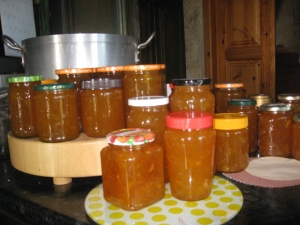DEFINITIVE MARMALADE RECIPE
Marmalade takes time to make and it needs watching. You cannot leave it and disappear. Don’t try to shorten the steps or make it when you are busy with something else. It can easily go wrong and hours of time will be wasted.
You need: 3 lbs Seville (bitter) oranges, 1 x large lemon, 1 x sweet orange, 5 pts water, 6 lbs sugar
A very sharp knife, cutting board, very very large saucepan or preferably a preserving pan, muslin, large bowl, plastic strainer, jug (to fit under strainer), wooden spoon and jars.
The above amount can be cooked in a large saucepan, the largest you have. If you have a preserving pan you can make one and a half times easily i.e. 4 ½ lbs fruit, 7 ½ pints water, 9 lbs sugar.
The fruit must be fresh and just ripe. Wash, and scrub if necessary with a clean brush. Cut in half, squeeze out the juice and pips (an electric lemon squeezer works best) and strain through a plastic strainer placed over a jug or bowl. Keep the pips and tie them with any pulp in a piece of muslin. Cut the peel into quarters and then slice (peel side facing down) into thick or thin pieces as you prefer. Place peel in large bowl along with the pips in the muslin and the juice of the fruit, and soak overnight in half the water. In the morning, gently pour the contents of the bowl into your pan and add the other half of the water. Tie the muslin bag to the side of the pan making sure it is below the water line. Bring slowly to a simmer. Once it has reached simmering point, boil for 2 hours until the peel is soft. Your water will probably have reduced to about one third so don’t worry.
Whilst this is cooking, prepare your jars. Wash them and dry in a warm oven. Warming prevents cracking when the marmalade is poured into them. Take pan off the heat. Remove the muslin bag and, once cool, squeeze out any liquid from the bag back into the pan. It’s important to get out as much as you can as this contains a lot of pectin which helps it all to set. If you do it with your bare hands the acid will eat away at them, but there’s not really an alternative. Make sure you don’t burst the muslin. Add the sugar slowly and stir in. Put back on the heat and stir slowly til dissolved. Bring to the boil and cook til setting point has been reached. It should be a walloping boil not just a simmer. You can add a knob of butter to reduce the scum. Just stir it in.
Test for setting. Spoon test: After about half an hour, test for setting with the spoon. Bang it on the side of the pan and when the marmalade runs off, you’ll see that it is starting to set when it congeals a bit on the spoon and the drips are slower and run together. If it’s still runny, keep boiling.
Wrinkle test: Once you get to the slow drip stage, put a teaspoon of the marmalade onto a saucer and cool it either in the fridge or freezer. When cool, the surface should be set and the marmalade should wrinkle when pushed with a finger. If it doesn’t wrinkle, return to the pan and keep boiling. Some people use a thermometer which they say is the best way. Look in your cook book on how to do this. You’ll find that it can take an hour to reach the point of setting, although in most books it says it will happen in 20 minutes. When the marmalade is ready leave it to cool slightly til a thin skin forms on the top. This is supposed to prevent the peel from rising to the top of the jars. Stir it gently and pour into the warm jars using a jug, keeping a saucer underneath to catch the drips. Put a waxed disc on top of each jar, pressing out the air, wipe the jars if sticky with a damp cloth and cover. Label and store in a cool dark place. If you’ve made it well, it will not need a use-by date as it will last years and most likely be eaten before then.

